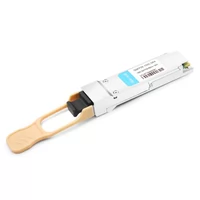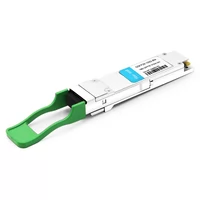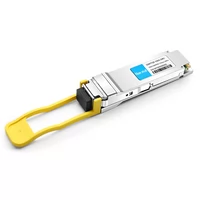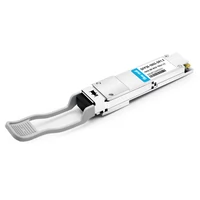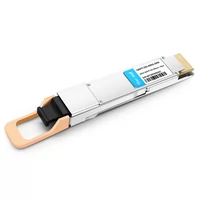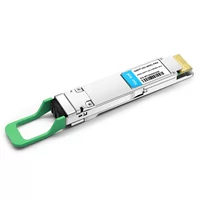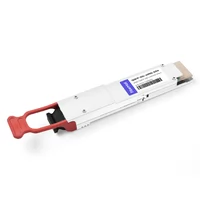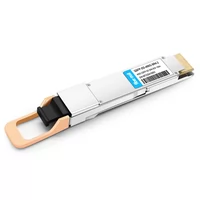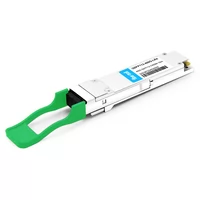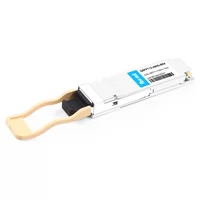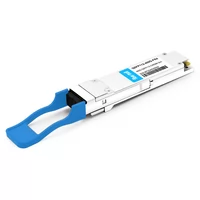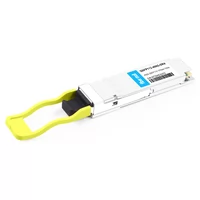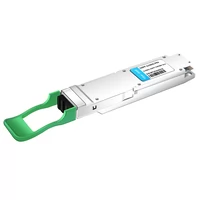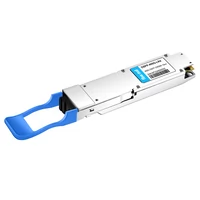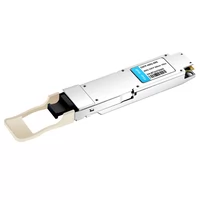Table of Contents
ToggleThe Background of the Birth of White-Box Switches
The background of the birth of white-box switches can be traced back to the continuous evolution and innovation of network architecture.
Explosive Growth of Network Data Volume
With the popularization and diversification of the Internet, the data volume in the network grows exponentially. Traditional network devices may face performance bottlenecks when dealing with such a huge data load. Therefore, higher performance and more flexible network devices are needed to meet the growing data demand.
The Rise of Cloud Computing and Big Data
The rise of cloud computing and big data technologies leads to the rapid expansion of data centers. Traditional network devices are difficult to adapt to the needs of large-scale data centers, and more scalable and customizable solutions are needed. White-box switches, with their programmability and customization features, provide better support for data centers.
The Programmability Requirement of the Network
Traditional network devices are usually based on closed hardware and operating systems, which make it difficult to meet the changing network needs. Modern networks require higher programmability, to adapt to new business needs and technological developments. The programmability of white-box switches enables them to be flexibly configured and managed according to actual needs.
The Rise of Software-Defined Networking (SDN)
SDN technology emphasizes the programmability and central control of the network, by separating the control plane and the data plane, it achieves more flexible network management and optimization. The combination of white-box switches and SDN technology enables network administrators to better control network behavior and further promotes the development of white-box switches.
The Impact of Open Source
The rise of the open-source movement has fostered innovation in various fields, including the network field. The development of open-source operating systems and software libraries has created favorable conditions for the emergence of white-box switches. Open-source software provides customizable solutions, making it easier for vendors to build white-box switches.
Lower Hardware Costs and Supply Chain Diversity
Traditional network devices are often produced by a few vendors, resulting in relatively high hardware costs and concentrated supply chains. White-box switches use commercial hardware, which can reduce hardware costs and promote supply chain diversity, allowing more vendors to participate in the production of network devices.
The History of White-Box Switches
The history of white-box switches can be traced back to the development and evolution of network technology.
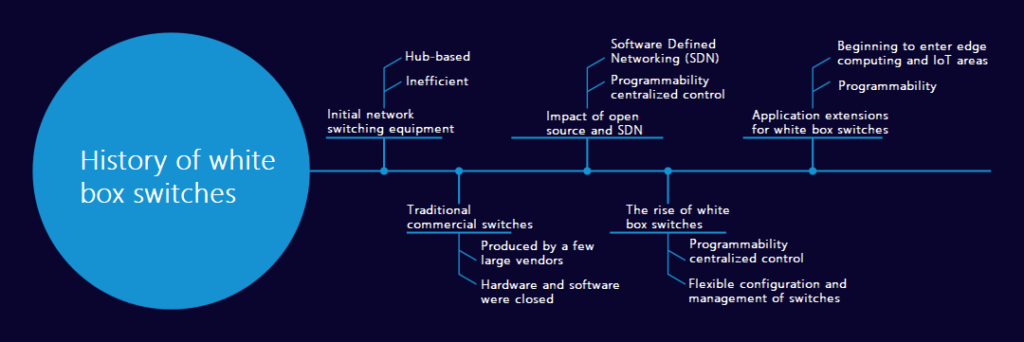
Early Network Switching Devices
In the early days of computer networks, hub-based network architectures were used, which were inefficient in terms of packet broadcasting. As the number of devices and data traffic in the network increased, people began to look for more efficient network-switching technologies.
Traditional Commercial Switches
Commercial switches began to be widely used in networks, and these switches were usually produced by some large manufacturers. The hardware and software of these switches were closed, and network administrators could only use the functions and configuration options provided by the manufacturers.
The Impact of Open Source and SDN
With the rise of the open-source movement, people began to seek more flexible and customizable network solutions. At the same time, the concept of software-defined networking (SDN) also attracted attention, advocating the programmability and central control of the network.
The Rise of White Box Switches
With the development of open-source operating systems, generic hardware and SDN, white box switches emerged. White box switches use commercial hardware, but run open-source operating systems, allowing network administrators to configure and manage switches more flexibly.
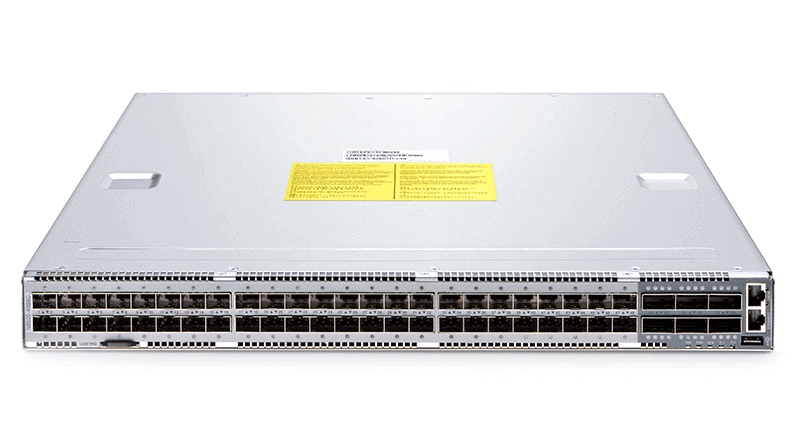
The Application Expansion of White Box Switches
White box switches are not only applied in data centers but also gradually enter other fields, such as edge computing, the Internet of Things, etc. These fields have different requirements for network flexibility and performance, and the programmability of white box switches enables them to adapt to these requirements.
Introduction to White Box Switches
The concept of white box switches was first proposed by network hardware vendor Big Switch Networks. The company launched an open network switching architecture in 2012, combining commercial hardware with open-source software operating systems, to achieve more flexible network configuration and management. They proposed the concept of white box switches under this architecture, intending to separate hardware and software so that network administrators can customize the configuration according to actual needs, and achieve higher levels of network control and optimization. Over time, the concept of white box switches has gradually gained wider recognition and application. Other manufacturers and open-source communities also began to pay attention to and invest in the research development and application of white box switch technology. Therefore, although it was first proposed by Big Switch Networks, the development of white box switches is a process involving multiple efforts.
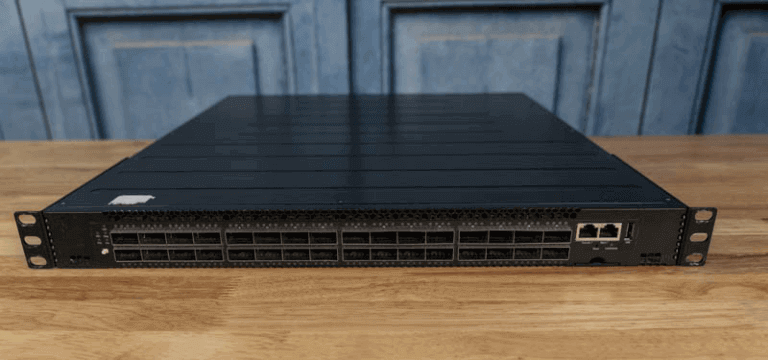
Overview of White Box Switch
White Box Switch, also known as White Label Switch, is an innovative network switching device featuring hardware and software decoupling, openness, and customizability. It plays an important role in modern network architecture, providing more flexible, programmable, and high-performance network solutions for enterprises and data centers.
Hardware and Software Decoupling
Traditional network switches usually integrate hardware and software tightly together, limiting network administrators’ ability to customize and control the devices. In contrast, white box switches are designed with decoupled hardware and software, allowing network administrators to independently configure and update hardware and software to better meet different network requirements.
Openness and customizability
White box switches are usually based on open-source operating systems, such as Linux, and open standard hardware. This allows users to customize it to their needs by adding or removing specific features and modules to suit different network architectures and business requirements. Openness also encourages the development of an ecosystem, thus providing users with more choices and innovation.
Based on Commercial Hardware
White box switches typically use commercial hardware, such as common chips and components. This reduces hardware costs and provides users with a more affordable solution. In addition, designs based on generic hardware promote diversity in the supply chain and reduce dependence on specific vendors.
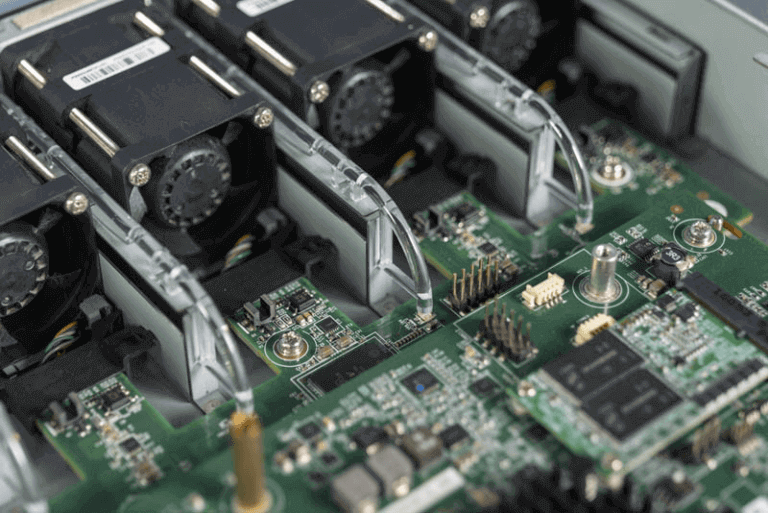
Large Enterprise Applications
Large enterprises and cloud service providers, such as Google, Microsoft, and Facebook, widely use white box switches in their large-scale data centers. These enterprises require high-performance, programmable, and customizable network devices to support complex network architectures and business requirements. The openness and flexibility of white box switches make them ideal for meeting these needs.
How White Box Switches Work
Imagine a white box switch as an intelligent traffic commander sitting at the crossroads of the network, precisely guiding the flow of data and ensuring that information reaches its destination quickly and accurately. It works a bit like a precision dance, consisting of hardware and software working in tandem to keep the networked world running smoothly.
First, the white box switch watches the packets coming in from different devices through a set of highly intelligent “eyes” – the ports. Each packet is like a car, and the port is the entrance to the road. The switch decides which exit the packet should go to by examining the “destination address” in the packet, just as it looks at the license plate number. This process is fast and almost instantaneous.
Then, in a manner similar to that of a mail sorter, the white box switch sorts the packets into the appropriate “mailboxes” (i.e., ports). Each port is connected to a different device, just as each mailbox belongs to a different recipient. The packet is delivered to exactly the right mailbox to ensure that it reaches the target device.
The “mail sorter” also has its own memory, it will remember the previous route, so that in the next encounter with the same “destination address” can be more quickly sorted packets, just as a skilled sorter can quickly identify the recipient.
The working principle of the white box switch is: with precise ports, intelligent judgment, and high-speed operation, it collects and classifies data packets from different devices, and then efficiently sends them to the right destinations, so as to build an unobstructed network traffic system, which allows information to be rapidly transmitted and our digital world to be more closely connected.
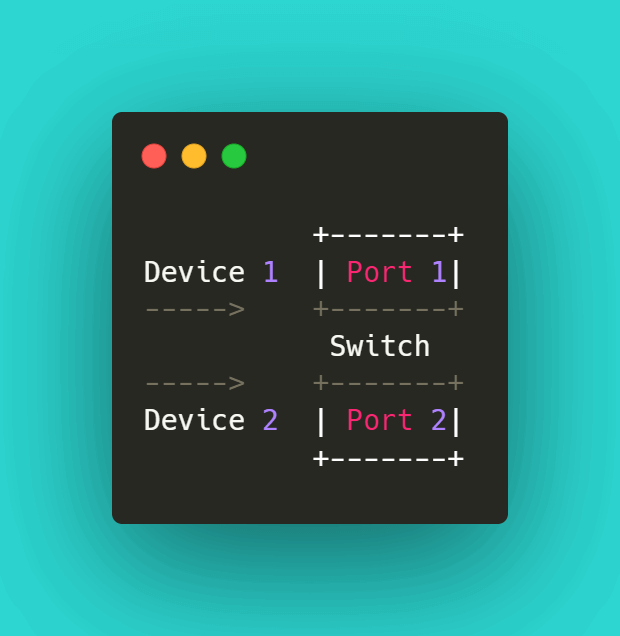
In the diagram above, there are two devices (Device 1 and Device 2) connected by a white box switch (Switch). The white box switch has two ports (Port 1 and Port 2), which connect to these two devices respectively. When Device 1 wants to send data to Device 2, it sends the data packet to Port 1 of Switch. Switch checks the destination address in the packet, and determines that it should send the packet to Device 2 through Port 2. This is like at an intersection, where the traffic police (Switch) instructs the vehicle (data packet) to go in the correct direction based on the license plate number (destination address). Through this process, the white box switch can efficiently transfer data packets from one device to another, ensuring that data can reach its destination accurately and quickly. This simple diagram helps illustrate how white box switches achieve data forwarding based on the destination address in the data packet.
Comparison of White Box Switches and Traditional Switches
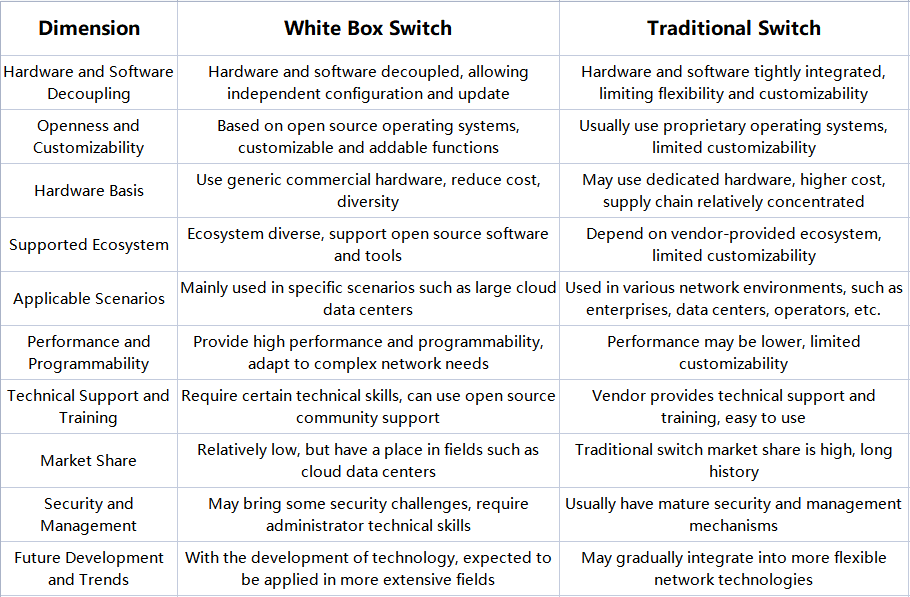
Built on Commercial Hardware
A notable feature of white box switches is that they use commercial hardware as the basis. Compared to traditional dedicated switches, this use of commercial hardware makes white box switches more cost-effective. Commercial hardware is usually based on generic processor architectures, which means that the manufacturing cost of hardware is low, and it is also easier to obtain. This feature of white box switches allows network administrators to choose the hardware configuration that suits their needs, thereby achieving customized network architectures. At the same time, it also promotes the diversity of the hardware supply chain, reducing the procurement cost of hardware devices.
Use Application-Specific Integrated Circuits (ASICs)
White box switches use application-specific integrated circuits (ASICs) from mature suppliers. ASICs are customized integrated circuit chips that are specially used to perform specific computing tasks. In white box switches, ASICs are used to implement data packet forwarding and processing, as well as various protocols and functions required for network switching. By using ASICs, white box switches can achieve high-performance data packet processing and forwarding, meeting the needs of large-scale data centers and networks. The customizability of ASICs also allows network administrators to optimize according to actual needs, improving network performance and efficiency.
Run Open Network Operating System (ONOS)
Another important feature is that white box switches run an open network operating system (ONOS). An open network operating system is a software system used to manage and control network devices, which emphasizes the programmability and flexibility of the network. By running ONOS, white box switches can achieve centralized network control and management. ONOS allows network administrators to configure and manage the network through a centralized controller, thereby achieving network automation and optimization. This programmability allows network administrators to formulate network policies according to actual needs, and dynamically adjust network behavior, thereby achieving more efficient data traffic management and resource utilization.
White Box Switches and Software-Defined Networking (SDN)
White box switches are often used in combination with software-defined networking (SDN), which is one of the most significant differences from traditional switches. SDN is a network architecture that emphasizes the programmability, central control, and separation of the data plane and the control plane of the network. The programmability and openness of white box switches make them an ideal choice for SDN architectures.
In SDN, white box switches act as part of the data plane, communicating with the centralized controller to adjust and optimize network behavior. This architecture allows network administrators to manage the entire network from a centralized location, thereby achieving higher levels of network automation and optimization.
In SDN, white box switches act as part of the data plane, communicating with the centralized controller to adjust and optimize network behavior. This architecture allows network administrators to manage the entire network from a centralized location, thereby achieving higher levels of network automation and optimization.
Advantages of White Box Switches
White box switches bring many advantages.
First, due to their open operating system, users can choose the network operating system that suits their needs, thereby optimizing network performance to the maximum extent. For example, they can choose operating systems that support different protocols according to actual needs, thereby achieving better performance and compatibility.
Second, the hardware cost of white box switches is relatively low, which provides an affordable network solution for small and medium-sized enterprises. Compared to traditional proprietary switches, white box switches use standardized hardware components, reducing procurement and maintenance costs.
In addition, their flexibility and programmability also allow network administrators to better adapt to changing business needs. Whether it is adding devices or adjusting network policies, white box switches can achieve this through software configuration, greatly simplifying the process of network management.
To summarize the advantages of white box switches:
o Simplicity
o Flexibility
o Reliability
o Scalability
o Customizability
o Automation
o High performance
o Cost-effectiveness
Application Cases of White Box Switches
Application in Cloud Computing Environment
White box switches play an important role in the cloud computing environment. Cloud data centers need to support large-scale virtualization and multi-tenant services, and the programmability of white box switches allows them to be flexibly configured according to different virtual network needs, achieving efficient utilization of resources and optimization of the network.
Edge Computing Network
With the rise of edge computing, there is a need to build a network with low latency and high bandwidth to support communication and data processing between edge devices. White box switches can be customized according to different edge scenarios, ensuring efficient connection between edge devices.
Large-Scale Data Center Interconnection
In large-scale data centers, there is a need for high-bandwidth, low-latency interconnection between multiple data centers. White box switches can meet the fast data transmission needs between data centers through their high-performance hardware and programmable features, supporting data center interconnection and resource sharing.
Vendors Involved in White Box Switches
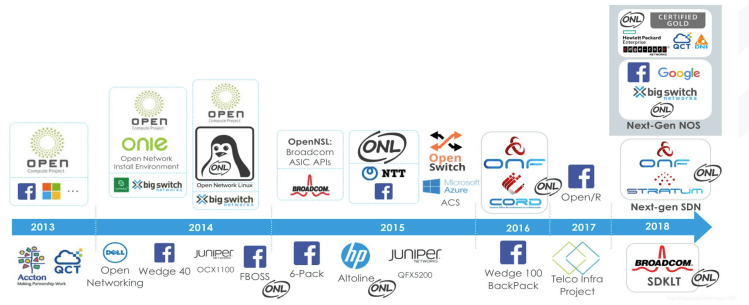
International Vendors
Big Switch Networks: As one of the proposers of the white box switch concept, Big Switch Networks has been researching and promoting the development of white box switch technology since 2010. Their innovations have made progress in software-defined networking (SDN) and open-source network operating systems.
Cumulus Networks: Cumulus Networks was founded in 2010, focusing on providing network operating systems for white box switches. They launched a Linux-based network operating system, providing network administrators with higher programmability and flexibility.
Pica8: Pica8 was founded in 2012, offering a network operating system based on white box switches. Their products aim to achieve network openness and programmability.
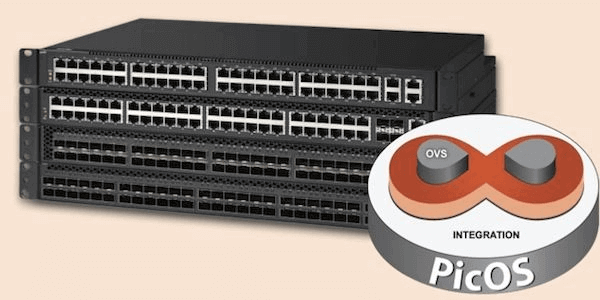
Chinese Vendors
Huawei: As China’s leading network equipment manufacturer, Huawei is also involved in the field of white box switches. Their products are mainly used for cloud data centers and enterprise networks, to support large-scale data traffic processing.
ZTE: ZTE is also an important domestic network equipment supplier, involved in the field of white box switches. Their products target different scales of network needs.
UNISOC: UNISOC has rich experience in the chip field, and they may also play a certain role in the research and development of white box switches.
Ruijie Networks: As one of the domestic network equipment manufacturers, Ruijie Networks is also involved in the field of white box switches.
Development Trends and Challenges of White Box Switches
Large cloud providers such as Google and Amazon have widely deployed white box switches in their data center networks. These providers need high-performance, highly programmable network devices to support large-scale cloud services. White box switches provide customized configuration and more flexible network management, enabling cloud providers to better adapt to rapidly changing business needs.

As the competition in the large cloud provider market becomes more intense, white box switch vendors begin to look at niche markets such as secondary cloud providers, large enterprises, and telecom service providers. This helps to expand the application scope of white box switches in different industries and further promotes market development.
The rise of white box switches has affected the market share of traditional network equipment manufacturers to some extent, especially in the data center switch field. These manufacturers need to adapt to the new market dynamics and maintain competitiveness through innovation. Cisco’s market share in data center switches has declined, which also reflects the impact of white box switches. Cisco and other traditional network equipment manufacturers are also constantly adjusting their product strategies to adapt to market changes, including providing more programmable and flexible devices.
In summary, white box switches, as an innovative network device, have shown their important role in promoting network technology evolution through their rapid growth in data center networks and their impact on market share. This trend indicates that the network field will continue to face change and innovation.
We will briefly list some of the challenges faced by white box switches below:
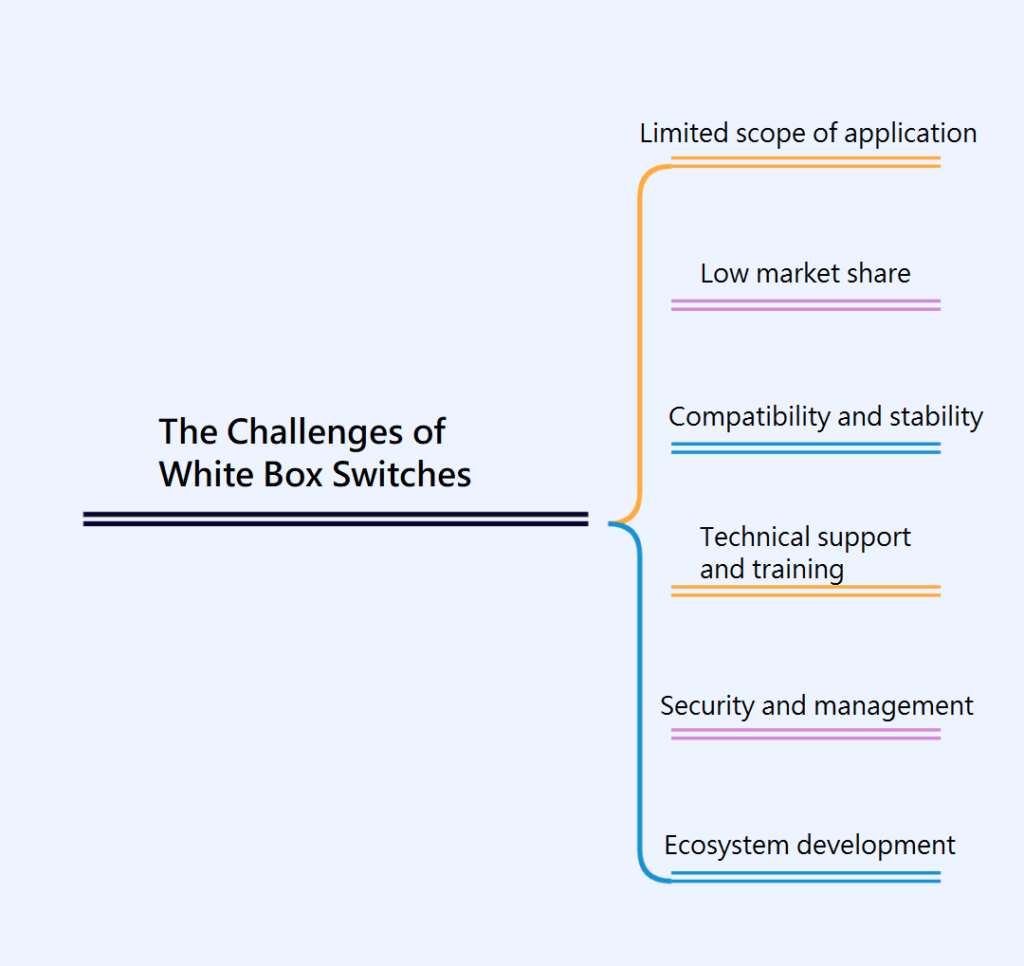
Limited scope of application: Currently, white-box switches are widely used in specific scenarios such as large-scale cloud data centers. In other scenarios, such as metropolitan area networks and wide area networks, the application of white-box switches is still in an early stage. This limits the scope of their widespread application.
Low market share: Although the white-box switch market is growing, its market share is still low compared to traditional switches. In most cases, white-box switches are deployed together with traditional switches, which may limit their performance advantages.
Compatibility and stability: Some white-box switches may encounter compatibility issues when integrating with different vendors’ hardware, operating systems or controllers. In addition, the use of open-source software and hardware may pose some stability challenges that require more testing and optimization.
Technical support and training: For some enterprises and network administrators, switching from traditional closed solutions to white-box switches requires a certain learning and adaptation process. The lack of training and technical support may make some institutions adopt a wait-and-see attitude towards adopting white-box switches.
Security and management: Openness and programmability may bring some security challenges, such as incorrect configuration that may lead to network vulnerabilities. Moreover, the management of white-box switches may require network administrators to have higher technical skills to fully exploit their potential.
Ecosystem development: White-box switches require a healthy ecosystem, including operating systems, controllers, applications, etc. The construction of this ecosystem may take time to provide users with complete solutions.
Conclusion
On the stage of the network, white-box switches lead the network revolution in the digital age with their characteristics of openness, customization, and innovation. They decouple hardware from software, allowing network administrators to customize according to their needs, redefining our understanding of the network. As a combination of hardware and software, white-box switches quickly emerge in fields such as data centers, enterprises, and large-scale cloud service providers. However, despite the infinite possibilities brought by white-box switches, they also face challenges, such as the limitation of application scenarios and the increase of market share. With the continuous evolution of technology, white-box switches are expected to play a role in a wider range of network environments, becoming a driving force for digital transformation. Whether from the perspective of innovation from openness or from the perspective of highly customized network experience, white-box switches are leading a new chapter of the network, allowing us to explore more possibilities in the digital world. No matter how the future changes, white-box switches will continue to show their dazzling brilliance on the stage of the network, leading us into a more colorful and diverse network era.
Related Products:
-
 QSFP28-100G-SR4 100G QSFP28 SR4 850nm 100m MTP/MPO MMF DDM Transceiver Module
$40.00
QSFP28-100G-SR4 100G QSFP28 SR4 850nm 100m MTP/MPO MMF DDM Transceiver Module
$40.00
-
 QSFP28-100G-IR4 100G QSFP28 IR4 1310nm (CWDM4) 2km LC SMF DDM Transceiver Module
$110.00
QSFP28-100G-IR4 100G QSFP28 IR4 1310nm (CWDM4) 2km LC SMF DDM Transceiver Module
$110.00
-
 QSFP28-100G-DR1 100G QSFP28 Single Lambda DR 1310nm 500m LC SMF with FEC DDM Optical Transceiver
$180.00
QSFP28-100G-DR1 100G QSFP28 Single Lambda DR 1310nm 500m LC SMF with FEC DDM Optical Transceiver
$180.00
-
 QSFP28-100G-SR1.2 Single Rate 100G QSFP28 BIDI 850nm & 900nm 100m LC MMF DDM Optical Transceiver
$280.00
QSFP28-100G-SR1.2 Single Rate 100G QSFP28 BIDI 850nm & 900nm 100m LC MMF DDM Optical Transceiver
$280.00
-
 QSFP-DD-400G-SR8 400G QSFP-DD SR8 PAM4 850nm 100m MTP/MPO OM3 FEC Optical Transceiver Module
$149.00
QSFP-DD-400G-SR8 400G QSFP-DD SR8 PAM4 850nm 100m MTP/MPO OM3 FEC Optical Transceiver Module
$149.00
-
 QSFP-DD-400G-FR4 400G QSFP-DD FR4 PAM4 CWDM4 2km LC SMF FEC Optical Transceiver Module
$500.00
QSFP-DD-400G-FR4 400G QSFP-DD FR4 PAM4 CWDM4 2km LC SMF FEC Optical Transceiver Module
$500.00
-
 QSFP-DD-400G-ER4 400G QSFP-DD ER4 PAM4 LWDM4 40km LC SMF without FEC Optical Transceiver Module
$3500.00
QSFP-DD-400G-ER4 400G QSFP-DD ER4 PAM4 LWDM4 40km LC SMF without FEC Optical Transceiver Module
$3500.00
-
 QSFP-DD-400G-SR4.2 400Gb/s QSFP-DD SR4 BiDi PAM4 850nm/910nm 100m/150m OM4/OM5 MMF MPO-12 FEC Optical Transceiver Module
$900.00
QSFP-DD-400G-SR4.2 400Gb/s QSFP-DD SR4 BiDi PAM4 850nm/910nm 100m/150m OM4/OM5 MMF MPO-12 FEC Optical Transceiver Module
$900.00
-
 QSFP112-400G-LR4 400G QSFP112 LR4 PAM4 CWDM 10km Duplex LC SMF FEC Optical Transceiver Module
$1500.00
QSFP112-400G-LR4 400G QSFP112 LR4 PAM4 CWDM 10km Duplex LC SMF FEC Optical Transceiver Module
$1500.00
-
 QSFP112-400G-SR4 400G QSFP112 SR4 PAM4 850nm 100m MTP/MPO-12 OM3 FEC Optical Transceiver Module
$450.00
QSFP112-400G-SR4 400G QSFP112 SR4 PAM4 850nm 100m MTP/MPO-12 OM3 FEC Optical Transceiver Module
$450.00
-
 QSFP112-400G-FR4 400G QSFP112 FR4 PAM4 CWDM 2km Duplex LC SMF FEC Optical Transceiver Module
$750.00
QSFP112-400G-FR4 400G QSFP112 FR4 PAM4 CWDM 2km Duplex LC SMF FEC Optical Transceiver Module
$750.00
-
 QSFP112-400G-DR4 400G QSFP112 DR4 PAM4 1310nm 500m MTP/MPO-12 with KP4 FEC Optical Transceiver Module
$650.00
QSFP112-400G-DR4 400G QSFP112 DR4 PAM4 1310nm 500m MTP/MPO-12 with KP4 FEC Optical Transceiver Module
$650.00
-
 NVIDIA MMS4X00-NS400 Compatible 400G OSFP DR4 Flat Top PAM4 1310nm MTP/MPO-12 500m SMF FEC Optical Transceiver Module
$700.00
NVIDIA MMS4X00-NS400 Compatible 400G OSFP DR4 Flat Top PAM4 1310nm MTP/MPO-12 500m SMF FEC Optical Transceiver Module
$700.00
-
 OSFP-2x200G-FR4 2x 200G OSFP FR4 PAM4 2x CWDM4 CS 2km SMF FEC Optical Transceiver Module
$1500.00
OSFP-2x200G-FR4 2x 200G OSFP FR4 PAM4 2x CWDM4 CS 2km SMF FEC Optical Transceiver Module
$1500.00
-
 OSFP-400G-LR4 400G LR4 OSFP PAM4 CWDM4 LC 10km SMF Optical Transceiver Module
$1199.00
OSFP-400G-LR4 400G LR4 OSFP PAM4 CWDM4 LC 10km SMF Optical Transceiver Module
$1199.00
-
 OSFP-400G-SR8 400G SR8 OSFP PAM4 850nm MTP/MPO-16 100m OM3 MMF FEC Optical Transceiver Module
$225.00
OSFP-400G-SR8 400G SR8 OSFP PAM4 850nm MTP/MPO-16 100m OM3 MMF FEC Optical Transceiver Module
$225.00

